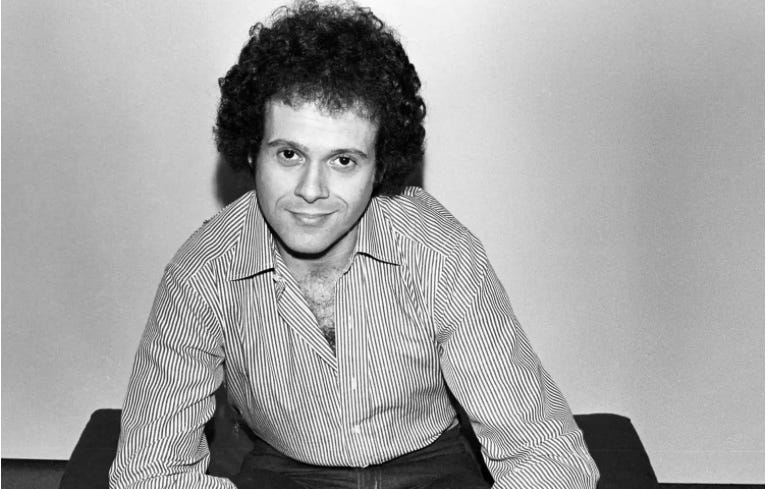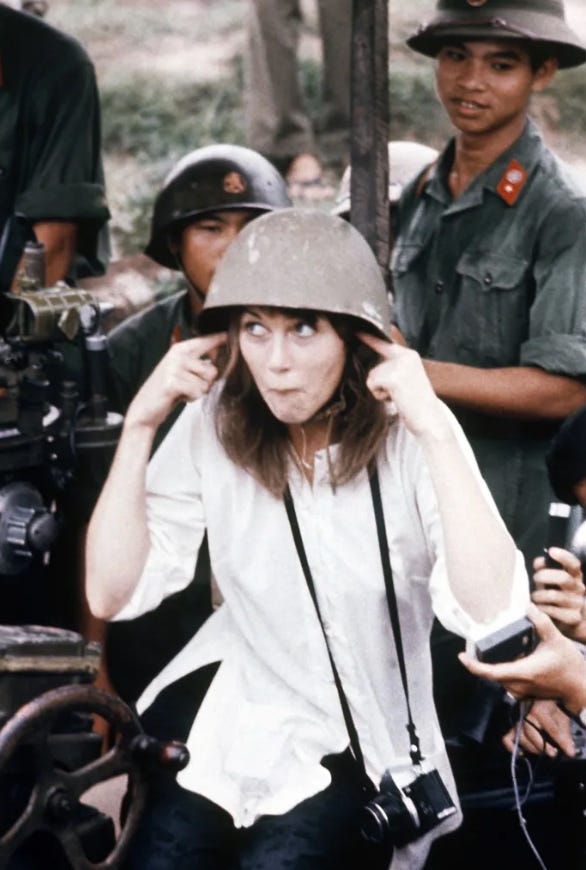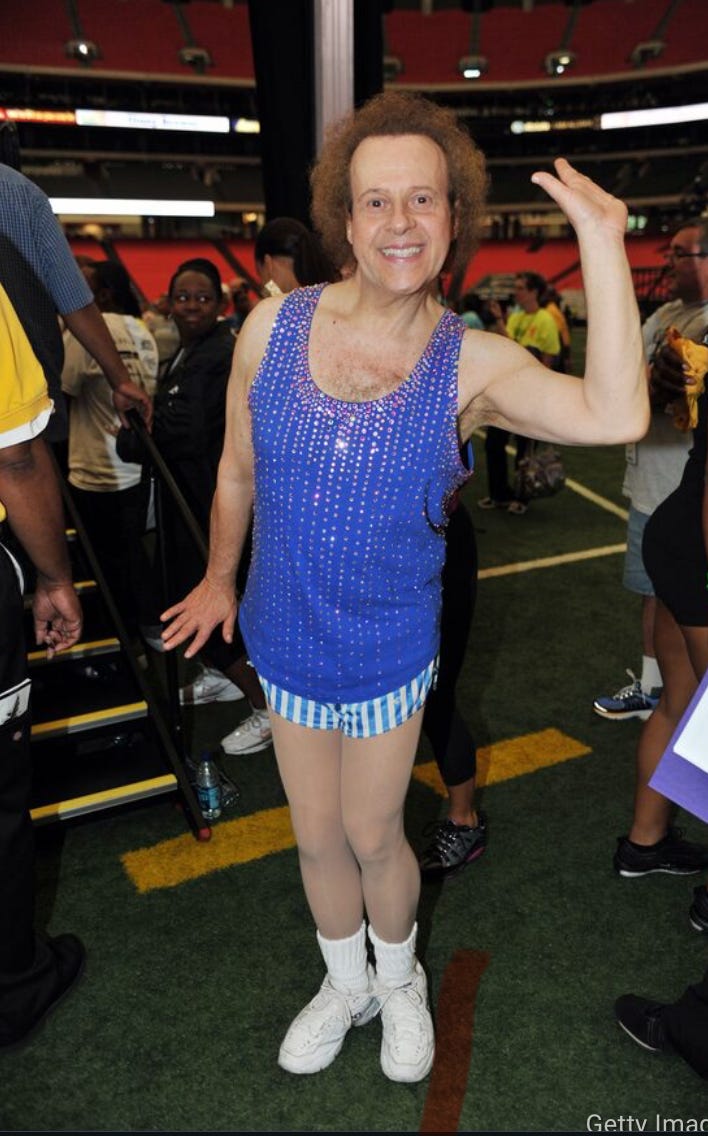[Before I begin I want everyone to know that this essay will not feature any gay jokes or fat jokes. We’re going to keep things respectful. Anyone commenting using words or phrases like “fruity,” “extra-fruity,” “fruitier than a banana plantation,” or commenting that someone, for instance, is probably prohibited from going to beaches due to her orbital pull disrupting tidal patterns- WILL BE BLOCKED!]
It seems like another world now. I can remember, decades ago, being sick and home from school, forced to watch daytime TV, my child-mind mystified at the lack of cartoons. My mom favored All My Children and The Price is Right; I remember watching Let’s Make a Deal when a contestant learned he had chosen an envelope containing $5,000 over the prize behind the curtain, a llama. I can still recall feeling sympathy for his missing out on that camelid. But one presence in particular from the early 80s of my youth still comes skipping out of my memory from time to time, and having read the title- if you’re old enough- you probably remember him too.
This guy!
Richard Simmons, in death, had the misfortune of being upstaged- for probably the only time in his life- by yet another 80s celebrity getting shot on live TV while running for president. His passing on July 13th of this year thus didn’t get the attention it probably otherwise would have. But in a way it was fitting, for in the last decade of his life Simmons had retreated from the fame he’d cultivated for reasons that ostensibly seemed fairly mysterious. In a way, he Mandela-effected himself out of existence at the end, becoming someone people were sure they once remembered being everywhere, but somehow now gone without leaving an empty space.
Richard Simmons was born Milton Teagle Simmons in the French Quarter of New Orleans, Louisiana in 1948; it is purely coincidental that this is the gayest part of the gayest city in the gayest state in the South. His was a minor showbiz family, with his father a former broadway performer turned local MC for hire and his mother a gymnast and fan dancer, but were otherwise working-class people. Though his father was Episcopalian and his mother Jewish, Simmons converted to Catholicism in his youth, which would become an important part of his identity. As is common with people who make fitness or exercise their life’s work, Simmons as a child was unhealthy and bullied by others, in his telling so morbidly obese that as a teenager he reached 268 pounds- now fairly typical among the poors but in his time scandalous.
No phones, no tablets, just folks having fun and, most importantly, getting some exercise.
His resolve to change his situation was positively Nietzschean. Beginning working life as praline salesman, Simmons realized he had more to offer the world than handling sugary nuts in The Big Easy and decided to go to college. His first instinct was to head to a seminary to become a Catholic priest, but he- somewhat bafflingly- decided he wouldn’t fit in. His next move marked a real shift, to Florida State University in decidedly unfabulous Tallahassee, where he graduated with a BA in Art. It was apparently at this point that he began calling himself Richard, after an uncle who helped him pay for school.
Even as a young man, Dick always came through for him.
Simmons moved to Los Angeles in 1973, the hub of entertainment and the exercise craze soon to be in full swing in the US. The generation that grew up after WWII lived very much in a land of abundance, and the leisure of life bred insecurities related to strength and fitness. Men wondered if they could measure up to their depression-forged fathers, and the Boomer fixation on youth and play meant that by the end of the decade the earliest members of that generation were hitting their late thirties and trying to stop there. Hollywood began shifting expectations as to what in meant to be in shape, foisting profoundly unrealistic ideals on both sexes.
Bodybuilding, coded strongly masculine, was epitomized by the rise of Arnold Schwarzenegger, who moved smoothly from elite competition into blockbuster films. As a sport, bodybuilding is a challenging and worthwhile endeavor; as a model of healthy fitness, to say the least, it leaves much to be desired. Somewhat better in terms of its effects on the body was the more feminine-coded aerobics, embodied by noted communist Jane Fonda. But even here, mileage varied, and the notion of thin-at-all-costs for women could lead to as many unhealthy places as the rampant abuse of anabolic steroids for men.
Fonda’s original fitness program, “Lose Weight the NVA Prison Camp Way,” also faced criticism.
Simmons became fascinated with exercise. He dropped 123 pounds through changes in diet and exercise and maintained a body weight close to 150 (at 5’7) for the remainder of his life. But along the way he discovered that, much like banks, gyms much preferred to cater to the people who least needed their products and services. If you were fat, you were out of luck- exercise space is for the already fit. Simmons, however, was undaunted, and like his canny Austrian contemporary he had a knack for business that extended far beyond an affinity for nuts. And like Comrade Fonda staring down American planes through the gunsights of Viet Cong AA, he saw clearly an opportunity to do something meaningful.
Despite having no formal background in exercise or health science as such, Simmons opened a combined health food restaurant and exercise studio, which eventually evolved into Slimmons (get it?), which would in turn become the glittering throne at the center of a media empire. Simmons cultivated celebrities and normies alike, and his unique personality soon brought him to the attention of television producers. This led to The Richard Simmons Show- the show I recall, in rerun form, from my childhood. The show won multiple Emmys, and though its run ended in 1985, it was only the beginning of a fitness and entertainment presence that would last for decades.
Simmons was less the king (I didn’t say queen) of daytime TV than its court jester (more on that to come). His flamboyant gregariousness and wholly non-threatening demeanor made him the perfect guest for any talk show or wacky morning round table. He was a regular on game shows requiring the presence of an affable and affordable celebrity. Most notably, he landed a recurring role on General Hospital (as himself) for several seasons. And all the while he personally taught classes, not only in his studio but in shopping malls around the country. Richard Simmons was everywhere.
A VHS rip seems most appropriate.
His look was, to say the least, distinctive. His frizzy curls, his Jim Carey-levels of animation, and his overall swishiness were near always showcased within a uniform consisting of some sort of bedazzled tank top and snug Dolfin shorts with an inseam length that could best be described as ‘theoretical.’ A joker might say that if he were any more camp he’d have to be fully manned by a marine at every entrance, but that’s hardly fair to a man who was very serious about his mission, no matter on what outlet he appeared.
I was going to mention rhinestones, but then I stumbled upon an interview where he specified he adorned his outfits with hundreds of dollars worth of Swarovski crystal. In another interview, Simmons stated that the Dolfin shorts are no longer sold in the US as they are extremely flammable. Ironically, that makes them the least flaming thing about h-[I’m stopping!]
And he always had something to showcase. Over the course of his career Simmons would author thirteen books and produce dozens upon dozens of fitness videos and DVDs, most notably his incredibly popular Sweatin’ to The Oldies series. He was not merely a celebrity fitness instructor, but a theorist, and not merely of exercise. Some have compared him to Oprah, advancing a kind of therapeutic outlook, but his approach was subtly different. It would be more accurate to call him a life coach avant le lettre, but unlike others in that field he was less interested in elite performance than helping the average person become the best normie he or she could be.
His basic philosophy was experiential- having been fat himself, he hated it, and took it for granted that others did as well. Upon that foundation came the realization that it was not merely what he ate that made him fat, but his lifestyle, and no particular diet would work so long as the impediments of habit remained to sabotage it. One sees echoes of this approach with modern fitness experts like Jeff Cavaliere of Athlean-X. He also realized that most people weren’t ubermenschen looking for a physique worthy of the Arnold Classic. There was a great appetite (so to speak) in America and beyond for a method for losing weight that would work and, most importantly, be enjoyable- something you would want and be able to do.
Like the criminally overlooked Bioneer, Simmons fundamentally believed that ‘if you’re moving, you’re improving:’
Look past what some (not this author) would call a presentation sugary enough to induce diabetic shock and you will find advice that is inarguably sound. In an industry absolutely plagued by ‘influencers’ hawking illusions based on their own chemically-enhanced and mediated physiques, Simmons was always down-to-earth, realistic, and honest. It’s true he had no muscle tone to speak of and you weren’t going to get jacked from his program. But that wasn’t really the point. Simmons had the body of a man who engaged in regular dancing and wasn’t a pig. It’s a level of fitness readily achievable by nearly anyone, and that America is as morbidly obese as it is while spending exorbitant sums on gym memberships, supplements, and fad diets says a lot about the degree to which mass obesity is as much a problem of self-delusion as it is our consumption habits.
There was nothing ‘body positive’ about Simmons. He never pretended it was ok to be fat, and though he was sympathetic to the men and women who came to him, after the requisite sobbing and hugs it was always time to push play on the Big Bopper cassette and start moving. Simmons was never harsh. He would never use put-downs like ‘lumbering buttersquatch,’ ‘seed-oil behemoth,’ or ‘galactic hambeast.’ Nor would he admonish his charges to abandon their sugar-based diets for the plankton nature intended for them. Like Joey Swoll, he kept it positive at all times. He was tough but encouraging, always wanting to bring out the best in people. As the title says, no one respected the wholesome chungus more than Richard Simmons, and it was his very genuine love for the average festively-plump personage that motivated him and in turn allowed him to motivate others. Over the course of his career he estimated that he helped people lose some 12 million pounds; I’m not sure about his calculations, but if true he may be more to blame for global warming in the 80s than aerosol hairspray. It was worth it.
But there was a cost to all of this outpouring of energy. For all of his charisma Simmons was in reality an introvert and an intensely private man. He described himself as lonely, with few friends, more inclined to spend time his mansion with his dogs than with any humans. He never married or had children. Some (not myself) have speculated that Simmons was so deep in the closet that his return address was Narnia, but he never spoke in public about his sexuality, and would become uncharacteristically angry if it were brought up. He is not known to have had any romantic relationships with any named person I can find, of either sex.
The based journalists in Africa would long since have cracked the mystery, but it’s perhaps best Simmons was left alone.
Simmons retired almost entirely from public view beginning in 2014, and spent the last decade of his life in relative seclusion. This in turn prompted all sorts of rumors, some plausible, some bizarre. Media figures speculated that he was being held hostage by his housekeeper, that he was transitioning like Bruce Jenner, or that he’d gone insane or was suffering from some disease. On the rare occasions he deigned to comment, he always gave the reason that he simply wanted time to himself.
As mentioned earlier, Simmons was fond of comparing himself to a court jester. In this interview with Men’s Health from 2012, republished after his death, he says the following on how he conceived of his role:
RS: (Laughs.) Ha! Well you know, I do consider myself a clown and a court jester, and I do love to make people laugh, whether they’re laughing with me or at me. I just love what I do, and I’m a teacher more than anything. When the king gets depressed, he doesn’t call for his wife. He doesn’t call for the cook. He calls for the court jester.
One is reminded of Pythagoras and his notion of the philosopher as being on the side, observing, a spectator and contemplative rather than a participant. For all of his fame Simmons saw himself as essentially ancillary to the world, as a supporting actor rather than a star. The glittering twink persona was part of the show; the man himself was humble and self-effacing. He could even take comfort in being laughed at so long as it brought some happiness to others. He wrought joy from his loneliness and turned his inner isolation to the benefit of others. The article noted- I don’t think incidentally- that Simmons rose before dawn to pray each day.
In the end, there was nothing strange happening in his final years. As with everything else, Simmons had been telling the truth; he just wanted time to himself. His housekeeper (who was not actually his housekeeper, but his personal assistant) gave a touching interview a week or so after his death (from a heart attack in his sleep) where she detailed working for Simmons for thirty-five years as his closest companion and confidant. This intensely outwardly engaging but inwardly deeply private man had been nothing but kind to her and everyone he knew, answering the voluminous fan mail that still came in years after he ceased to be a public figure. In a sense, the last part of his life was not especially mysterious; he spent his youth scattering himself like seeds and in his final years he gathered himself back in. He always thought of his calling in religious terms, noting in the first interview linked earlier that that was the source of the discipline that made his program work. I like to think that however he lived his life outside of the public eye that he made his peace with God before the end.
At several points in my research for this I came across people comparing Simmons to two other figures from the period- Fred Rogers and Bob Ross. I think there is something very much to this. All three represented models of manhood that were, in a sense, challenging and ambiguous. Rogers presented as a soft-spoken single man (on his show) who enjoyed the company of children. Simmons was, well, not exactly Conan the Barbarian. And Ross gave off a harmless hippy vibe, painting landscapes at a time when dropping crucifixes in urine was the edgy ideal. All three cultivated an aesthetic persona of meekness, love of others, and a holistic approach to their craft that went beyond the technical to care for the whole person. They were, all three, teachers and healers. There’s a kind of arc that connects them; Rogers the mentor of youth, teaching kindness and confidence, Simmons the midlife guide steering one clear of the pitfalls of sloth and despair, and Ross the reminder in old age that it’s never too late to learn and be creative. In isolation aspects of their character might be viewed as weird or even threatening. But what saved them from being creepy was their profound moral vision, born from their common Christianity, and that most manly trait they all shared, the courage to embark on a life of service.
So pray for the soul of Richard Simmons. Ave atque vale, requiescat in pace.









This is a really excellent tribute. I too was very sad to see that Richard Simmons had died, to me he always represented a kinder, gentler, more inclusive, less cynical, and more fundamentally decent America. He was able to reach a lot of people where they were and help them improve and extend their lives, and certainly accomplished more for public health than most professionals in that field. I was saddened in his final years when the punchlines had gotten so mean and cruel, as he had definitely contributed so much positivity over the years.
Absolutely amazing work. You hit every note. I hope we see more biopic content like this in the future.